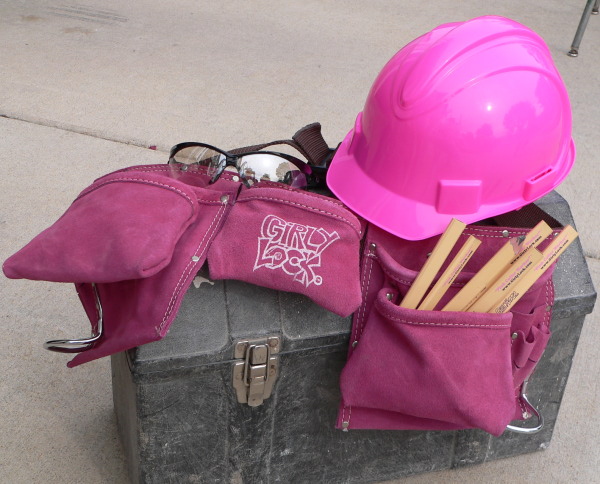By Janice Denham
Monday, April 13, 2009 11:18 AM CDT
Janice Denham Journal / Journeyman Sharon Sitler of Jennings, left, and apprentice Meghan McKenzie of Clayton get information and practice at the St. Louis Carpenters' Joint Apprenticeship Program in Affton.
 In the construction trades, only 1 percent of the workforce in Missouri consists of women. Teresa Willis, director of Missouri Women in Trades, points to that as a challenge for her group to become known among women who might choose a career as carpenter, electrician, welder or paperhanger.
In the construction trades, only 1 percent of the workforce in Missouri consists of women. Teresa Willis, director of Missouri Women in Trades, points to that as a challenge for her group to become known among women who might choose a career as carpenter, electrician, welder or paperhanger.The group can provide camaraderie for those working in such trades.
"Women don't see each other when they are working out there," Willis said. "It's nice to come together with other women experiencing the same things you are going through."
Even in a tight construction market, the group raises awareness that women can do these jobs, and there is opportunity in this industry which allows a woman to be paid well and raise a family.
Willis said the industry only stands to gain from increasing the number of women in the field, as it needs to focus more on women as a minority in the trades. Expectation is the workforce will need an infusion as baby boomers retire and traditional labor pools become harder to tap.
"An organization like ours, in an industry where it has mainly men, has value in that we can help them learn what the issues are that women face," Willis said.
Path to building
A woman already working may not arrive carrying her dad's - or even less likely, her mom's - hammer.
 Lynda Mueller Drendel is the only woman of 15 full-time instructors in the St. Louis Carpenters' Joint Apprenticeship Training Program in Affton. With a college degree in social work, she was a non-union carpenter for eight years in New Orleans. Joining the union after working in St. Louis gives her a double perspective.
Lynda Mueller Drendel is the only woman of 15 full-time instructors in the St. Louis Carpenters' Joint Apprenticeship Training Program in Affton. With a college degree in social work, she was a non-union carpenter for eight years in New Orleans. Joining the union after working in St. Louis gives her a double perspective.Janice Denham Journal / Lynda Mueller Drendel of south St. Louis, instructor in the Carpenters' Joint Apprenticeship Program, works with Steve Newland of Sedalia.
Equally at home wearing a hard hat or grading tests on OSHA requirements, she said the pay and benefits of health insurance and pension make the union attractive.
"The work is psychologically and physically challenging," Drendel said. "Union training makes the job definitely safer for both men and women."
Although women working in a predominantly male environment may feel isolated at times, she sees them gain confidence while on the job.
When Drendel started teaching, she found her attitude of impressing girls with a spirit that women can achieve anything needed an update.
"Women of today, just like my 11-year-old daughter, already know that," Drendel said. "Stereotypes have changed."
She and her husband, Bill, and their daughter, Anna, live in south St. Louis.
"There is no difference in the teaching," Drendel said. "Every carpenter has to find your strengths. Mine is trim (work), which I also teach."
Accommodation with a sense of humor helps both sides, too. A 25-pound tool belt can bruise narrow hips, but everyone learns the value of steel-toed work boots, earplugs, hard hat and gloves.
Years to prepare
To become a carpenter apprentice, a union contractor must sponsor an applicant. Four years on the job later, with a return to the training facility two weeks every six months, the apprentice becomes a journeyman.
Meghan McKenzie of Clayton has been an apprentice for about a year. After working as a manager in work camps for Campus Crusade for Christ, including relief after Hurricane Katrina, she came to Tarlton Corp. with a bachelor's degree in engineering science from Purdue University.
Fellow employees encouraged her to diversify from her position as project engineer. Whether welding, helping drive piles or learning scaffolding, McKenzie has gained new perspective on what she has designed.
"I kind of like to be in the midst of what is going on rather than in an office," McKenzie said.
Drendel, one of her teachers, hopes women tradesmen such as McKenzie will tap into Missouri Women in Trades to find the support they need to do their jobs better.
Tool turnaround constructs benefits for women in trades
Tools, even old ones, can encourage women to become new carpenters, plumbers, painters and other construction workers.
Missouri Women in Trades (MOWIT) will sell new and used tools and
construction equipment at a Tool Turnaround Saturday, April 25, at 8300 Manchester Road in Brentwood. A $10 donation allows early birds to check the supply from 7 to 9 a.m. before the sale opens to the public at 9 a.m. and runs until 5 p.m.
Besides the rain-or-shine sale, free activities for all ages include tradeswoman challenges and information about careers for women in the construction trades. A silent auction of handcrafted arts and crafts "? including shelves, tables, plant stands and stained glass windows "? made by tradeswomen will be offered.
Tools still can be donated for the sale. Collection sites are listed on the website http://www.mowit.org/.
Proceeds provide learning experiences for groups of girls, such as the Girl Scouts and students in technical schools, and career counseling for interested girls and women, plus support groups for women in the trades. MOWIT will offer a week-long day camp from July 13 through 17 for girls entering grades 10 through 12.
http://suburbanjournals.stltoday.com/articles/2009/04/13/west/news//0415ssj-toolturnaround01.txt











